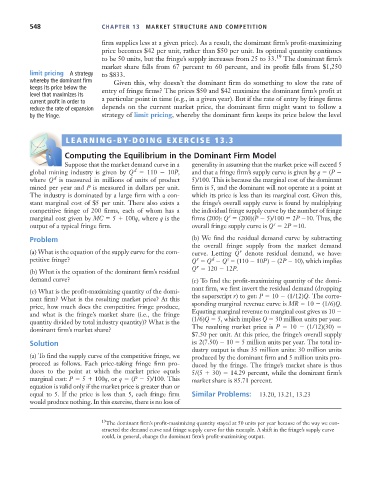Page 574 - Microeconomics, Fourth Edition
P. 574
c13marketstructureandcompetition.qxd 7/30/10 10:44 AM Page 548
548 CHAPTER 13 MARKET STRUCTURE AND COMPETITION
firm supplies less at a given price). As a result, the dominant firm’s profit-maximizing
price becomes $42 per unit, rather than $50 per unit. Its optimal quantity continues
to be 50 units, but the fringe’s supply increases from 25 to 33. 19 The dominant firm’s
market share falls from 67 percent to 60 percent, and its profit falls from $1,250
limit pricing A strategy to $833.
whereby the dominant firm Given this, why doesn’t the dominant firm do something to slow the rate of
keeps its price below the entry of fringe firms? The prices $50 and $42 maximize the dominant firm’s profit at
level that maximizes its
current profit in order to a particular point in time (e.g., in a given year). But if the rate of entry by fringe firms
reduce the rate of expansion depends on the current market price, the dominant firm might want to follow a
by the fringe. strategy of limit pricing, whereby the dominant firm keeps its price below the level
LEARNING-BY-DOING EXERCISE 13.3
S
D
E
Computing the Equilibrium in the Dominant Firm Model
Suppose that the market demand curve in a generality in assuming that the market price will exceed 5
d
global mining industry is given by Q 110 10P, and that a fringe firm’s supply curve is given by q (P
d
where Q is measured in millions of units of product 5)/100. This is because the marginal cost of the dominant
mined per year and P is measured in dollars per unit. firm is 5, and the dominant will not operate at a point at
The industry is dominated by a large firm with a con- which its price is less than its marginal cost. Given this,
stant marginal cost of $5 per unit. There also exists a the fringe’s overall supply curve is found by multiplying
competitive fringe of 200 firms, each of whom has a the individual fringe supply curve by the number of fringe
s
marginal cost given by MC 5 100q, where q is the firms (200): Q (200)(P 5)/100 2P 10. Thus, the
s
output of a typical fringe firm. overall fringe supply curve is Q 2P 10.
Problem (b) We find the residual demand curve by subtracting
the overall fringe supply from the market demand
r
(a) What is the equation of the supply curve for the com- curve. Letting Q denote residual demand, we have:
petitive fringe? Q Q Q (110 10P) (2P 10), which implies
d
r
s
r
Q 120 12P.
(b) What is the equation of the dominant firm’s residual
demand curve? (c) To find the profit-maximizing quantity of the domi-
nant firm, we first invert the residual demand (dropping
(c) What is the profit-maximizing quantity of the domi-
the superscript r) to get: P 10 (1/12)Q. The corre-
nant firm? What is the resulting market price? At this
price, how much does the competitive fringe produce, sponding marginal revenue curve is MR 10 (1/6)Q.
Equating marginal revenue to marginal cost gives us 10
and what is the fringe’s market share (i.e., the fringe
quantity divided by total industry quantity)? What is the (1/6)Q 5, which implies Q 30 million units per year.
The resulting market price is P 10 (1/12)(30)
dominant firm’s market share?
$7.50 per unit. At this price, the fringe’s overall supply
Solution is: 2(7.50) 10 5 million units per year. The total in-
dustry output is thus 35 million units: 30 million units
(a) To find the supply curve of the competitive fringe, we produced by the dominant firm and 5 million units pro-
proceed as follows. Each price-taking fringe firm pro- duced by the fringe. The fringe’s market share is thus
duces to the point at which the market price equals 5/(5 30) 14.29 percent, while the dominant firm’s
marginal cost: P 5 100q, or q (P 5)/100. This market share is 85.71 percent.
equation is valid only if the market price is greater than or
equal to 5. If the price is less than 5, each fringe firm Similar Problems: 13.20, 13.21, 13.23
would produce nothing. In this exercise, there is no loss of
19 The dominant firm’s profit-maximizing quantity stayed at 50 units per year because of the way we con-
structed the demand curve and fringe supply curve for this example. A shift in the fringe’s supply curve
could, in general, change the dominant firm’s profit-maximizing output.

